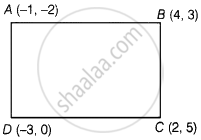Advertisements
Advertisements
Question
The points A(–1, –2), B(4, 3), C(2, 5) and D(–3, 0) in that order form a rectangle.
Options
True
False
Solution
This statement is True.
Explanation:

Distance between A(–1, –2), B(4, 3),
AB = `sqrt((x_2 - x_1)^2 + (y_2 - y_1)^2`
AB = `sqrt((4 + 1)^2 + (3 + 2)^2`
= `sqrt(5^2 + 5^2)`
= `sqrt(25 + 25)`
= `5sqrt(2)`
Distance between C(2, 5) and D(–3, 0),
CD = `sqrt((x_2 - x_1)^2 + (y_2 - y_1)^2`
CD = `sqrt((-3 - 2)^2 + (0 - 5)^2`
= `sqrt((-5)^2 + (-5)^2)`
= `sqrt(25 + 25)`
= `5sqrt(2)`
Distance between A(–1, –2) and D(–3, 0),
AD = `sqrt((-3 + 1)^2 + (0 + 2)^2`
= `sqrt((-2)^2 + 2^2)`
= `sqrt(4 + 4)`
= `2sqrt(2)`
And distance between B(4, 3) and C(2, 5),
BC = `sqrt((4 - 2)^2 + (3 - 5)^2`
= `sqrt(2^2 + (-2)^2)`
= `sqrt(4 + 4)`
= `2sqrt(2)`
We know that, in a rectangle, opposite sides and equal diagonals are equal and bisect each other.
Since, AB = CD and AD = BC
Also, distance between A(–1, –2) and C(2, 5),
AC = `sqrt((2 + 1)^2 + (5 + 2)^2`
= `sqrt(3^2 + 7^2)`
= `sqrt(9 + 49)`
= `sqrt(58)`
And distance between D(–3, 0) and B(4, 3),
DB = `sqrt((4 + 3)^2 + (3 - 0)^2`
= `sqrt(7^2 + 3^2)`
= `sqrt(49 + 9)`
= `sqrt(58)`
Since, diagonals AC and BD are equal.
Hence, the points A(–1, – 2), B(4, 3), C(2, 5) and D(–3, 0) form a rectangle.
APPEARS IN
RELATED QUESTIONS
If the point P(x, y) is equidistant from the points A(a + b, b – a) and B(a – b, a + b). Prove that bx = ay.
Find the distance between the following pairs of points:
(2, 3), (4, 1)
If P (x , y ) is equidistant from the points A (7,1) and B (3,5) find the relation between x and y
Find the distance of the following point from the origin :
(6 , 8)
Find the distance between the following point :
(sec θ , tan θ) and (- tan θ , sec θ)
Points A (-3, -2), B (-6, a), C (-3, -4) and D (0, -1) are the vertices of quadrilateral ABCD; find a if 'a' is negative and AB = CD.
If the length of the segment joining point L(x, 7) and point M(1, 15) is 10 cm, then the value of x is ______
Show that the point (0, 9) is equidistant from the points (– 4, 1) and (4, 1)
The distance between the points A(0, 6) and B(0, -2) is ______.
The distance of the point P(–6, 8) from the origin is ______.
